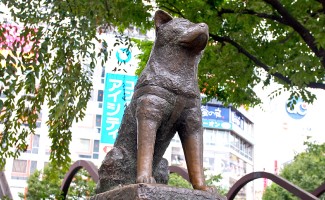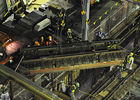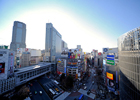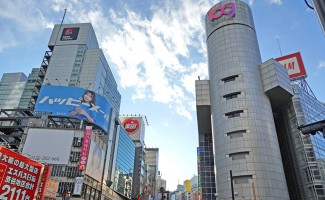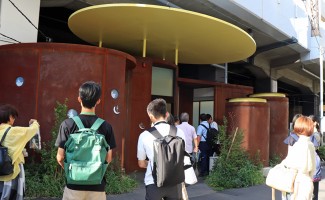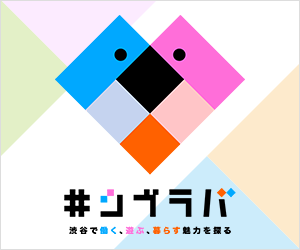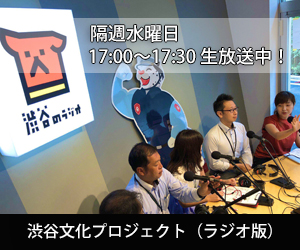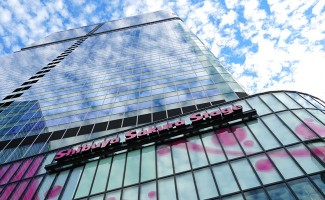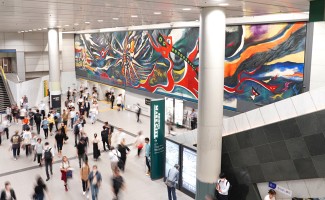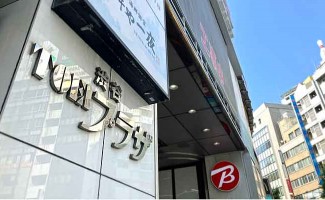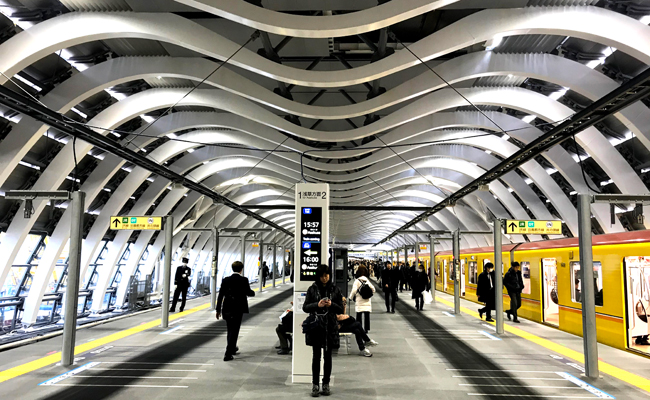
GINZA LINE Shibuya Station History and New Home
The major pillars of the ongoing redevelopment of Shibuya Station are the three major railway transfers.
1. On March 16, 2013, TOKYU TOYOKO LINE underground
2. Relocated to GINZA LINE Shibuya Station on January 3, 2020
3. Relocation of JR SAIKYO LINE home in early 2020 (planned)
Except for the relocation of the No. 3 JR SAIKYO LINE home, the major movement has already been completed. The first `` Toyoko Line Underground Switching Work '' is to switch the underground line between Shibuya Station and Daikanyama Station in the middle of March 15, 2013, only three and a half hours from the last train of the Toyoko Line to the first morning of the next morning. It was a god's work. It can be said that it is a construction that remains in history. Later, SHIBUYA STREAM and SHIBUYA SCRAMBLE SQUARE East Building opened on the site of Shibuya Station above the Kamaboko roof and the viaduct site.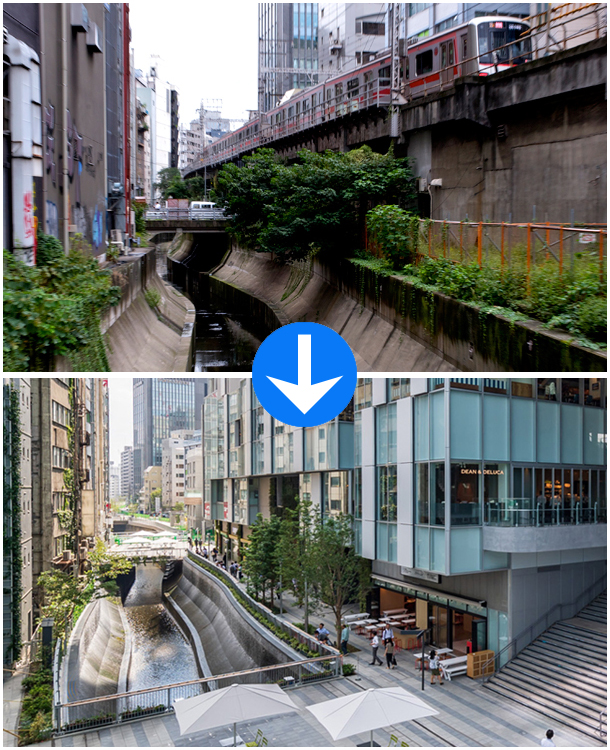 ▲ above =TOKYU TOYOKO LINE running along the Shibuya River (taken on September 19, 2012) Below =SHIBUYA STREAM opened at the Toyoko Line ground track
▲ above =TOKYU TOYOKO LINE running along the Shibuya River (taken on September 19, 2012) Below =SHIBUYA STREAM opened at the Toyoko Line ground track
The second major trip is Shibuya Station, which was recently established on January 3, Tokyo Metro Co.,Ltd. GINZA LINE. The old platform was moved about 130 meters to the Omotesando side, and a new home was opened just above Meiji-dori. Lastly, the JR SAIKYO LINE home at the “New South Exit” will be relocated next to YAMANOTE LINE by the time before the Olympics, making it easier to transfer. When it comes to "redevelopment," it is easy to focus on large-scale commercial facilities, but in the case of Shibuya Station redevelopment, the weight of "transport infrastructure development," which exceeds capacity, is large.
Now, let's take a concrete look at how the newly built “ GINZA LINE Shibuya Station” has changed from the three major railway trips. But before that, I would like to look back on the history of Shibuya Station on the GINZA LINE in the first place.
| Shibuya-Asakusa to drive directly after subway initiative
Keita Goto of Toyoko Yokohama Electric Railway (now TOKYU CORPORATION) will make a full connection between Shibuya and Kanagawa on the Toyoko Line in 1927. Along with this, Shibuya will play an important role as the key to the traffic junction connecting the city center and the suburbs. Next, Goto focused on a subway that could connect the inside of the YAMANOTE LINE to the suburbs. The Japanese subway began in 1927 when Tokyo Subway, led by Tokuji Hayakawa, opened the route between Ueno and Asakusa. After that, the track was extended, and in 1934 it was completely connected to Shimbashi. Inspired by this, Mr. Goto and others launched the Tokyo High Speed Rail, and in 1938 passed the subway between Shibuya and Toranomon, and opened the GINZA LINE Shibuya Station platform on the 3rd and 4th floors of the Toyoko Store West Building (then Tamada Building). Install and start using. Shibuya Station, which has a valley topography, has an unusual structure that includes a platform on the 3rd and 4th floors of the building, despite the subway, because the elevation difference is 18m from Omotesando Station, the next station.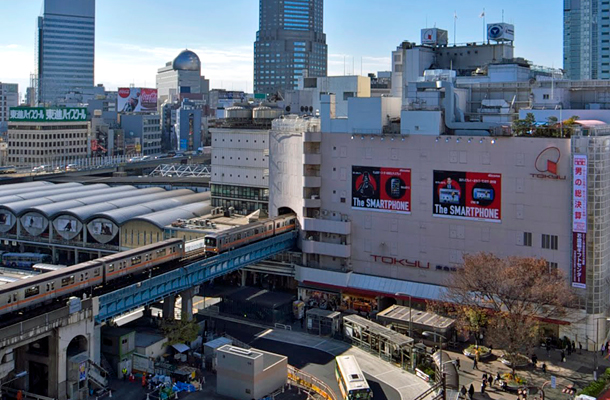 ▲ GINZA LINE jumping out of Toyoko Department Store Tokyu (Photo taken in April 2013)
▲ GINZA LINE jumping out of Toyoko Department Store Tokyu (Photo taken in April 2013)
Mr. Goto proposes to contact Mr. Hayakawa on the Tokyo subway at Shimbashi Station in order to get from Shibuya to Ginza and Asakusa, but rejects it completely. Mr. Hayakawa plans to enter Keihin Electric Railway (now Keikyu) on the Shinagawa route. Mr. Goto will forcibly take a hostile takeover, but eventually the government will intervene and arbitrate. The government invested to establish the Teito Expressway Transportation Company (currently Tokyo Metro Co.,Ltd.) and started operating the company subway in 1941. At present, the GINZA LINE operates directly between Shibuya and Asakusa, but the birth of the birth was a history of intense battle for initiative.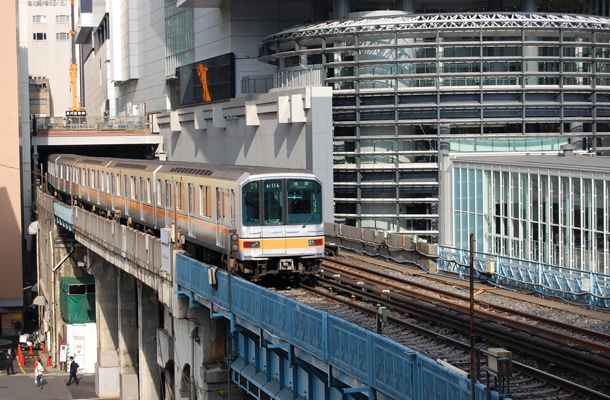 ▲ GINZA LINE before relocating home (Photo taken in April 2013)
▲ GINZA LINE before relocating home (Photo taken in April 2013)
| New station building featuring M-shaped arch form
After a quick look back at history, let's return to the relocation of the new GINZA LINE Shibuya Station platform. The main reason for the relocation of the platform this time is that the building, including facilities and facilities, has deteriorated considerably since 82 years since the station opened. Despite the terminal station boasting 220,000 passengers per day (2018), there are no elevators, home doors, toilets, and special structure integrated with department stores, so it is possible to transfer to other routes It was complicated and inconvenient.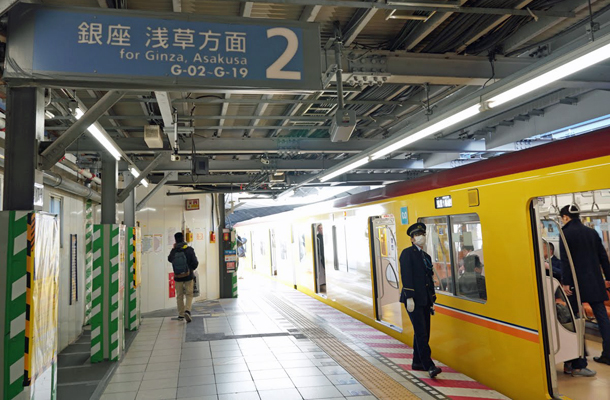 ▲ The 82-year-old, dilapidated old GINZA LINE Shibuya Station had a narrow platform width of 6 meters and was crowded during rush hours (December 27, 2019)
▲ The 82-year-old, dilapidated old GINZA LINE Shibuya Station had a narrow platform width of 6 meters and was crowded during rush hours (December 27, 2019)
Another big issue was that the platform width was narrow, and there was not enough capacity during the rush hour to commute to work, and there was a queue outside the ticket gate. At the time of the Olympics, the number of passengers is expected to increase further, so it can be said that relocating the platform at this time was a must.
So what's new about the newly built GINZA LINE Shibuya Station?
The biggest change is that the platform itself moved 130 meters to the Omotesando side and was newly built just above Meiji Dori. Looking at the exterior from Meiji-dori, the unique form of the M-shaped arch is conspicuous, but the station building is included in it.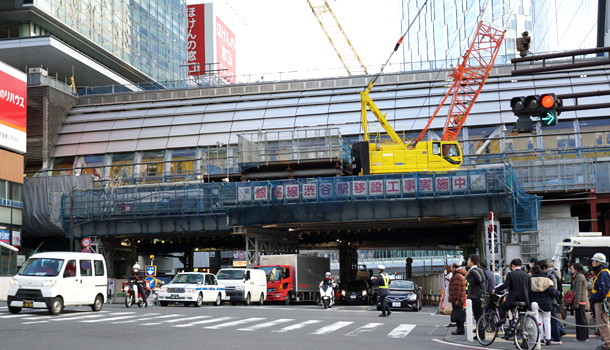 ▲ A new home just above Meiji Dori covered with an M-shaped arched roof. In the future, the roof will be a pedestrian-only passage “Skyway”.
▲ A new home just above Meiji Dori covered with an M-shaped arched roof. In the future, the roof will be a pedestrian-only passage “Skyway”.
The interior is characterized by a spacious home space with no pillars, a continuous row of arched roof steel, and you can feel as if you were inside a giant whale or dinosaur. Outside light shines into the station building, and the whole station is open and very bright.
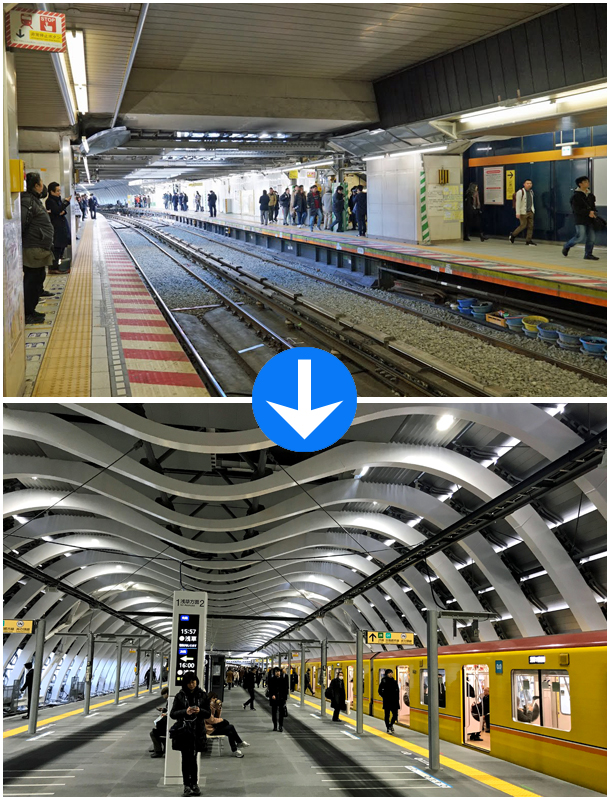 ▲ Top = Former GINZA LINE Shibuya Station is a two-sided two-line platform (taken on December 27, 2019) Bottom = New GINZA LINE Shibuya Station relocated directly above Meiji Dori
▲ Top = Former GINZA LINE Shibuya Station is a two-sided two-line platform (taken on December 27, 2019) Bottom = New GINZA LINE Shibuya Station relocated directly above Meiji Dori
Next, let's look at the functional aspects. The former GINZA LINE Shibuya Station platform was a two-sided, two-line relative platform where riding (Kobeya kitchen side) and getting off (Itoya side) were different, but the new platform was changed to a one-sided, two-line island platform . The width of the platform has been doubled from 6 meters to 12 meters due to the centralization of the two existing platforms in the center.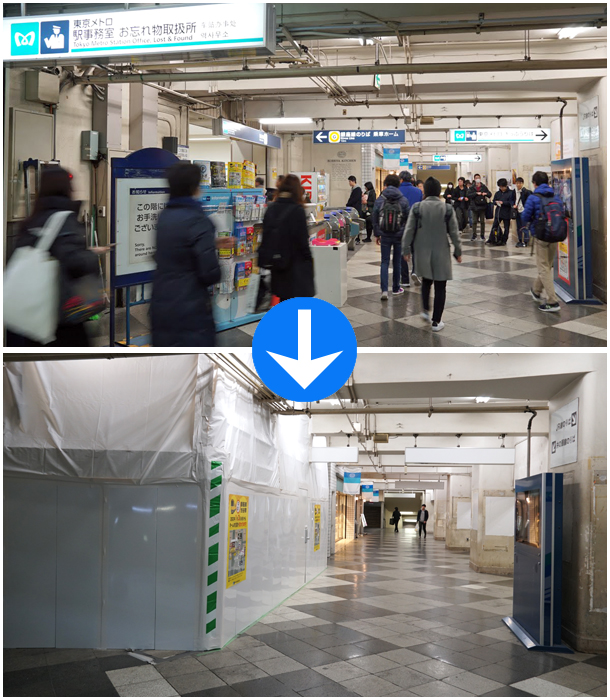 ▲ Top = Gate on the old GINZA LINE Shibuya Station (taken on December 27, 2019) Bottom = old boarding platform closed (taken on January 6, 2020)
▲ Top = Gate on the old GINZA LINE Shibuya Station (taken on December 27, 2019) Bottom = old boarding platform closed (taken on January 6, 2020)
The old platform has different boarding and disembarking facilities, and has five ticket gates. In many cases, people who are unfamiliar with Shibuya are puzzled to change. By moving the new platform to the island type on Meiji-dori, the ticket gates were consolidated into two places, the first car side and the last car side, so that the same platform and ticket gate can be used for both getting on and off This is a major change.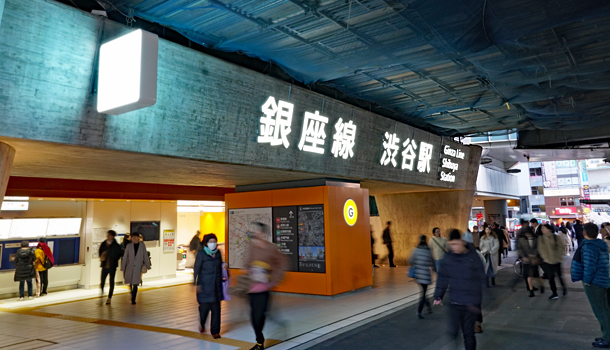 ▲ GINZA LINE Shibuya Station "Meiji-dori direction ticket gate" is newly established under the viaduct adjacent to Shibuya Hikarie(when Shibuya area is the first vehicle, the last side)
▲ GINZA LINE Shibuya Station "Meiji-dori direction ticket gate" is newly established under the viaduct adjacent to Shibuya Hikarie(when Shibuya area is the first vehicle, the last side)
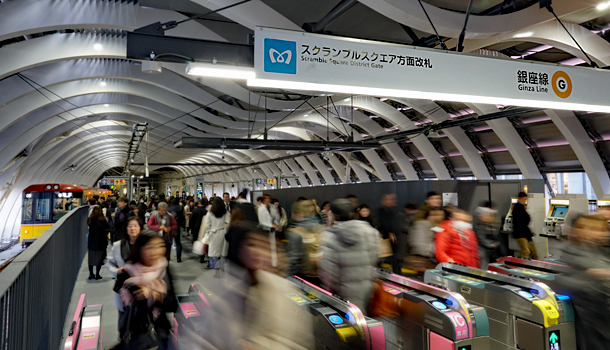 ▲ "Scramble Square ticket gate" is newly established on the leading vehicle side to Shibuya
▲ "Scramble Square ticket gate" is newly established on the leading vehicle side to Shibuya
The only toilet that was not installed at Tokyo Metro Co.,Ltd. was a new multifunctional toilet on the second floor of the "Meiji-dori Gate" (Shibuya Hikarie side).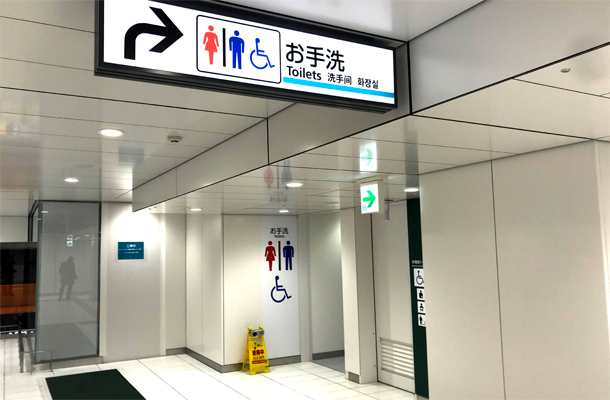 ▲ "Multi-functional toilet" is newly installed on the second floor of the ticket gate for the Meiji Road
▲ "Multi-functional toilet" is newly installed on the second floor of the ticket gate for the Meiji Road
In FY2020, we plan to install general toilets on the opposite side of the "Scramble Square Gate" side, for a total of two places. Elevators and home doors are not in operation yet, but maintenance is planned within 2020. If an elevator is needed at this stage, it is possible to use the elevator inside SHIBUYA SCRAMBLE SQUARE.
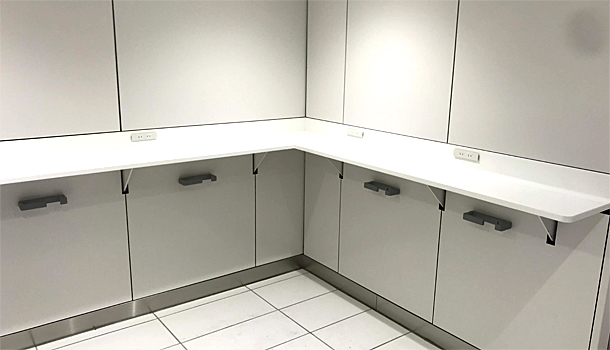 ▲ There is a "power counter" opposite the multifunctional toilet.
▲ There is a "power counter" opposite the multifunctional toilet.
Another power supply counter is located opposite the multifunctional toilet on the second floor of the ticket gate for Meiji-dori (Shibuya Hikarie side). While waiting for the train, it seems that you can do a little work such as charging your mobile phone or PC. It's a slightly recessed space on the second floor, so many people may not be aware of it.
Relocation of new home will increase congestion during rush hours!
By the way, it is a new home that has been in service since January 3, and it is pointed out that congestion during the morning rush is higher than before. In particular INOKASHIRA LINE the time of transfer from, Previously it climb the JR Tamagawa opening near the stairs, but was soon, a new entrance gate is SHIBUYA SCRAMBLE SQUARE, Shibuya Hikarie because it was aggregated to the side, to the JR central ticket gate direction It is said that the large stairs going around cause heavy traffic.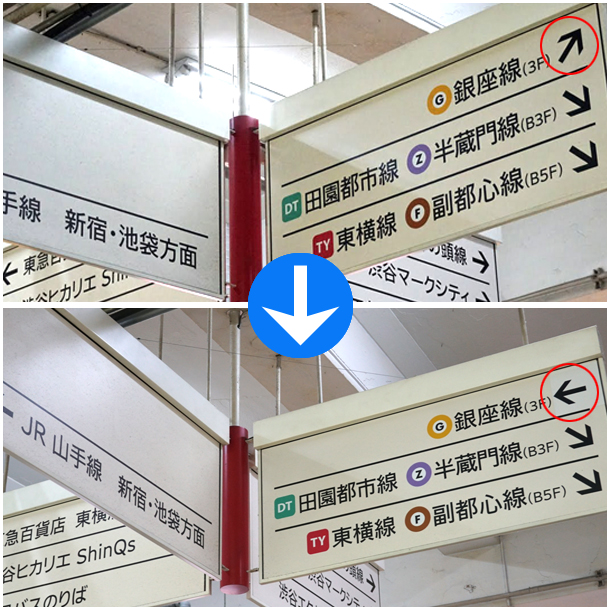 ▲ Change of sign arrow near Tamagawa Exit of JR Shibuya Station.
▲ Change of sign arrow near Tamagawa Exit of JR Shibuya Station.
Due to the congestion, mixing and dispersal, the GINZA LINE old exit platform (Itoya side) can still be used as a connecting passage.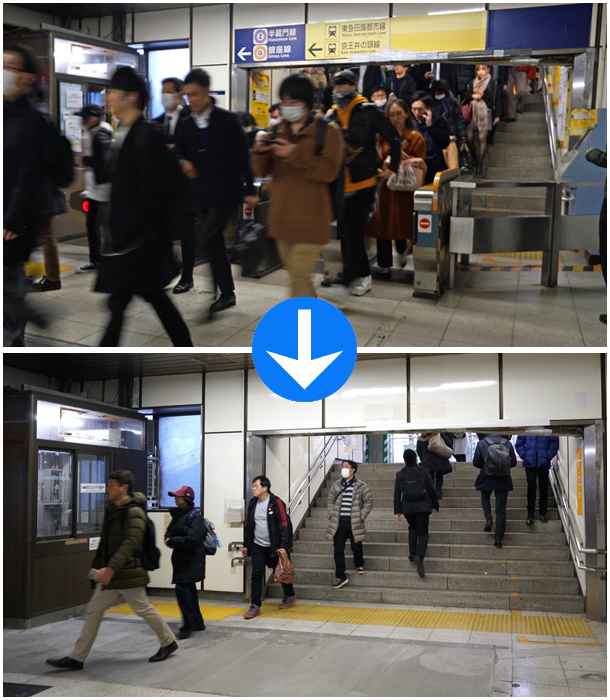 ▲ Top =GINZA LINE exit opposite the JR YAMANOTE LINE Central Gate (December 27, 2019) Bottom = After the transfer, the automatic ticket gate has been removed, and the dismounting platform can be used as a walkway until dismantling (Photo taken on January 6, 2020)
▲ Top =GINZA LINE exit opposite the JR YAMANOTE LINE Central Gate (December 27, 2019) Bottom = After the transfer, the automatic ticket gate has been removed, and the dismounting platform can be used as a walkway until dismantling (Photo taken on January 6, 2020)
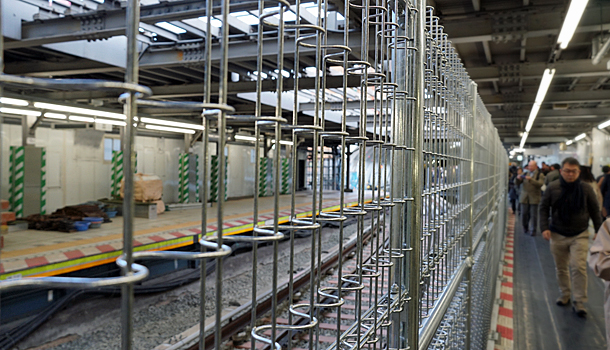 ▲ The old boarding platform is visible beyond the wire mesh. The old boarding platform is completely closed (taken on January 6, 2020)
▲ The old boarding platform is visible beyond the wire mesh. The old boarding platform is completely closed (taken on January 6, 2020)
Perhaps after the Olympics, until the dismantling of the Toyoko store west building is in full swing, the "old get off platform" could be used as it is.
In addition, on January 29, the JR Shibuya Station Central East Gate, which is directly connected to SHIBUYA SCRAMBLE SQUARE, will also be in service.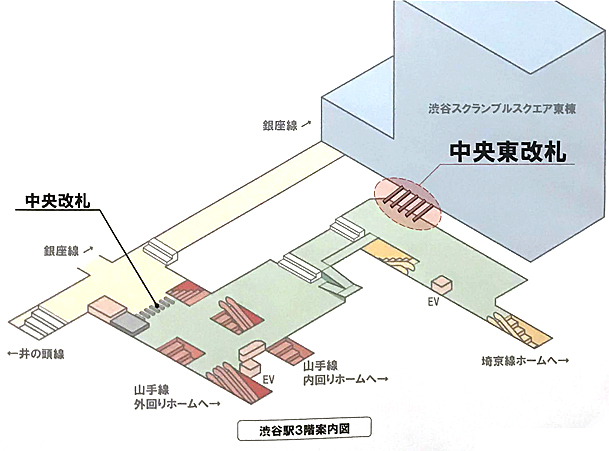 Since the GINZA LINE ticket gate is close to the Central East ticket gate, the use of the Central East ticket gate will increase at a stretch when switching from JR to the GINZA LINE after 29th. In that case, we hope that traffic congestion from the INOKASHIRA LINE to the JR Central Ticket Gate will be eased a little.
Since the GINZA LINE ticket gate is close to the Central East ticket gate, the use of the Central East ticket gate will increase at a stretch when switching from JR to the GINZA LINE after 29th. In that case, we hope that traffic congestion from the INOKASHIRA LINE to the JR Central Ticket Gate will be eased a little.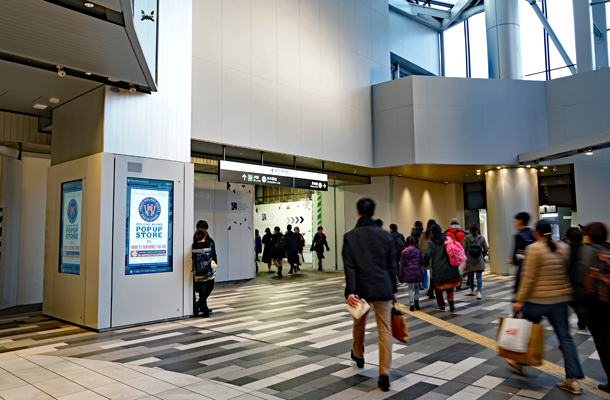 ▲ SHIBUYA SCRAMBLE SQUARE Urban Core 3F. The center is for the JR Central ticket gate, and the right hand is for the GINZA LINE Scramble Square. The JR Central East ticket gate will be newly established around the back of the left pillar.
▲ SHIBUYA SCRAMBLE SQUARE Urban Core 3F. The center is for the JR Central ticket gate, and the right hand is for the GINZA LINE Scramble Square. The JR Central East ticket gate will be newly established around the back of the left pillar.
At Shibuya Station, which is undergoing redevelopment, new and old facilities are combined in a complicated manner, and even if one becomes more convenient, other new issues will surface. It will take some time for all issues to be resolved.

Editorial department · Fuji Itakashi
Shibuya registrar. In addition to Shibuya of Culture information, seasonal news and topics, it will spell write that feel every day.

